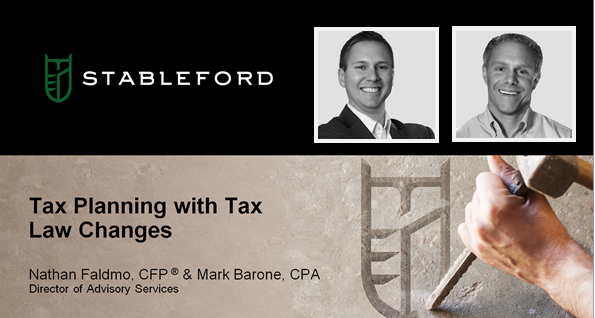You may have questions about how the changes to the tax code will affect your personal tax return this year. Some of the changes may be beneficial, while others may have some extensive effects on your return. Knowing the changes and how best to maximize your investments will smooth the way into tax planning season.
In this webinar, we discuss the potential positive and negative effects the tax reforms may have on your personal tax returns, as well as simple tips to maximize your investments when it comes to tax time.
The Good: Take Advantage of These Reforms
“They changed the tax brackets… and in general, if you’re talking apples to apples on your income, you’re going to pay less in tax… most people’s income is going to be pushed into a lower bracket rate-wise.” -Mark Barone, Accounting and Tax Specialist
Many of the beneficial changes make it possible for those earning under certain thresholds to save and reduce overall taxes.
 The marriage penalty no longer applies to many. If you make under $400,000, your tax rate will no longer increase after marriage.
The marriage penalty no longer applies to many. If you make under $400,000, your tax rate will no longer increase after marriage.- Personal exemptions have been eliminated. Now they are combined with the standard deduction. This is up to $12,000 per person ($24,000 per couple). Any deductions over this amount can be itemized.
- The child credit has doubled to $2,000. This applies to those with an income under $400,000.
- The alternative minimum tax, which calculates the bare minimum of what each person should pay, has increased to a $1 million threshold.
- Uses for 529 plans have expanded to include tuition from kindergarten through college. This creates greater options for those choosing private schools.
These changes provide a break on big life events like marriage, having children and paying for tuition.
The Not so Good: Be Aware of These Changes
With these reforms come some changes that may reduce your investment savings. Many of these include changes to what can be deducted.
- The mortgage interest deduction has been reduced from $1 million to $750,000. If your mortgage is over $750,000 you must prorate how much you get to deduct as far as mortgage interest dollars.
- Previously, job-related moving expenses would be deductible, but moving
 for work is no longer deductible for the individual taxpayer. However, it is for businesses. If you must move for work, ask your company to pay as they can still deduct it.
for work is no longer deductible for the individual taxpayer. However, it is for businesses. If you must move for work, ask your company to pay as they can still deduct it. - As of 2018 and onwards, alimony payments are no longer deductible. They are also not counted in the income of the recipient.
- Some deductions have been lost at the state level. Now only $10,000 of income and real estate can be deducted. However, what some may lose on this may be made up by moving out of the alternative minimum tax threshold. Alternative minimum tax does not include state and local taxes.
- Deductions have been lost on unreimbursed business expenses. Broker and CPA fees can no longer be deducted either. It is important to ask employers to reimburse these now.
- A Traditional 401k may be converted to a Roth IRA. Changing it back to Traditional was a recharacterization. Doing so could save in taxes. Now, the IRA recharacterization has been eliminated.
It is important to be aware of how these changes may affect your tax return and bring your concerns to your tax planning professional early.
4 Simple Tips for Tax Planning
The goal of tax planning is to reduce overall taxes. Taking four simple steps throughout the year can help you achieve breaks on your tax return, as well as put your money to work.
- Maximize retirement savings, including 401k, self-employed plans, other retirement plans, and IRAs.

- Fund a health savings account (HSA). This is a rainy day account for medical purposes and makes for an above the line deduction directly against your income. In 2020, a family can save $7,100 in an HSA and get a deduction. This is a tax benefit on medical expenses.
- Utilizing the gift tax exclusion if your estate is under the $11.4 million threshold can be a good way to save on taxes. Each person can gift up to $14,000 to a recipient per year. Both a father and mother can give the full $14,000 to one child in the same year, for a total of $28,000 tax-free.
- Some states, like Arizona, have credits which allow taxpayers to decide where their tax dollars go. Arizona’s tax credits include public school, private school, working poor and foster care categories.
“If you remember anything from this, credits and savings in taxes, like AMT, are good things. Take advantage of that and give some money to some really good charities that need it.” -Mark Barone
Using these steps keeps your money in your hands, with your loved ones’, or goes to bettering your community, all while reducing your overall taxes. Remember, credits make for better reductions on taxes than deductions, so take full advantage.
If you have more questions about the tax reforms or saving on your tax return, enlist Stableford Capital tax services by calling our main tax line at 480.998.0911 or contact us online.
